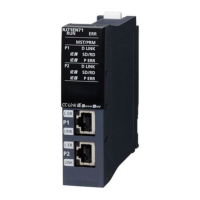106
8 SFC PROGRAM
8.5 SFC Program Execution Order
■Precautions
• If the transition for a step becomes TRUE at the first execution, the step starts/ends after one scan. When the step ends
after one scan, the following operation is performed according to the transition condition.
• The actions of active steps in a block are executed simultaneously (within the same scan). For this reason, do not create
SFC programs which depend on the execution sequence of actions.
• In the case of "Continuous transition," when a transition from one step to multiple steps occurs due to jump sequence or
selective convergence, the action of one step may be performed twice in one scan.
• In the case of "Continuous transition," if a program that loops using the jump sequence is executed, an error will occur.
• In the case of "Continuous transition" (operation compatible with FX3) where the transition destination step of jump
sequence is positioned above the transition source in the SFC chart, the destination step will be executed in the next scan
even if the transition becomes TRUE.
No continuous transition Continuous transition With continuous transition (operation
compatible with FX3)
I/O refresh of coil output, etc. is not reflected. To
reflect the I/O refresh, design the program so that
one step is scanned several times. However,
turning on of the step relay can be detected before
the previous scan (just after the transition from the
previous step) even in another program.
I/O refresh of coil output, etc. is not reflected, and
turning on of coil output cannot be detected in any
other program. To reflect the I/O refresh, design
the program so that one step is scanned several
times.
The step is started and ended in different scans,
and coil output in an action can be detected by
another program. However, the step relay is turned
off in a scan in which the transition becomes TRUE.
The execution sequence of actions (1), (2), and (3) are
undefined.

